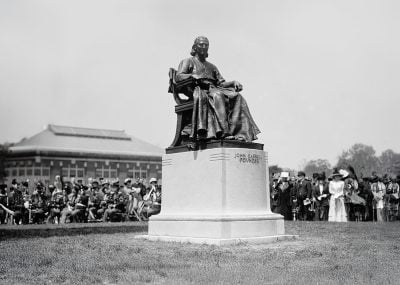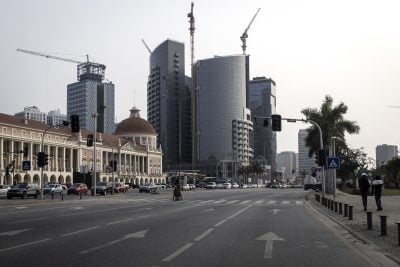Tanzania celebrates 50 years of independence on 9 December 2011. It has been 50 years of hard work and sometimes, pain. But, although the “three enemies” that the “Father of the Nation” Julius Nyerere targeted for elimination after independence (ignorance, poverty and disease) are not totally defeated, the country has come a long way from where the British left it in 1961. Happy Birthday Tanzania!
Julius Kambarage Nyerere was 39 years old when he led Tanganyika to independence on 9 December 1961. As one of 26 children of his father, Nyerere Burito, the chief of Zanaki, Julius had known poverty under British colonial rule. He was fortunate to get higher education at all, and even that came through scholarships. His studies, firstly at Makerere University in the Ugandan capital, Kampala, secondly at the University of Edinburgh in Scotland, all came by the grace of free tuition and boarding. Although a chief of his people, Burito’s meagre income could not have taken his son, who later became known as Mwalimu (or teacher in Swahili, for that was his real acquired profession) and Baba wa Taifa (Father of the Nation), anywhere.
This is attested to by the fact that Nyerere had the enviable record of being the first Tanganyikan student to attend a British university. And Britain had taken control of Tanganyika from Germany through a League of Nations mandate in 1919, three years before Nyerere was born.
Britain’s lukewarm attitude to Tanganyika was informed by fear – the fear that Tanganyika might one day revert to its original colonial master, Germany. Britain, as a rule, did not develop its many colonies spread across the world to any appreciable level anyway, and it was not going to pay much attention to a territory it was holding in trust for somebody who might turn up one day and reclaim it.
That was Tanganyika’s misfortune. Officially it was a “trusteeship” as compared to Kenya, which was a British “protectorate”. And that explains the huge gap in the development of the two neighbouring countries – Kenya being much more developed under British rule, and Tanganyika barely scraping through under British rule. There was a reason for the madness!
Tanganyika’s economy at the time was built around sisal, cotton and coffee. The three crops accounted for 54% of internal revenue. Africans grew 80% of the cotton and coffee at the time. But cotton and coffee were not the top cash earners. Sisal was. But sisal and three other crops – tea, tobacco and pyrethrum – were grown by settlers who were largely European and a mix of Asians. And that was where the money was.
You can thus understand what Nyerere was driving at when he said in a keynote address in Accra at Ghana’s 40th independence anniversary in 1997: “Ghana’s independence from colonial rule in 1957 was recognised for what it was: the beginning of the end of colonialism for the whole of Africa. For centuries, we had been oppressed and humiliated as Africans. We were hunted and enslaved as Africans, and we were colonised as Africans.
“The humiliation of Africans became the glorification of others. So we felt our Africanness. We knew that we were one people, and that we had one destiny regardless of the artificial boundaries which the colonialists had invented.
“Since we were humiliated as Africans, we had to be liberated as Africans. So 40 years ago, we recognised [Ghana’s] independence as the first triumph in Africa’s struggle for freedom and dignity. It was the first success of our demand to be given the international respect which is accorded free peoples.”
Freedom
Thank God, Tanganyikan independence came without much bloodshed, and the irony was not lost on Nyerere when years later Tanzania became the home of thousands of African freedom fighters who were shedding blood to free themselves in South Africa, Zimbabwe, Mozambique, Namibia and Angola.
Nyerere had returned from Edinburgh University in 1954 to find the Tanganyika African Association (TAA), a civic organisation formed in 1929 to fight for improvements in African lives, needing impetus. He had worked with the TAA while at Makerere University where he founded the Tanganyika Welfare Association (TWA).
Back home from Edingburgh, where he had been influenced by Fabian ideas, the young Nyerere took a teaching position at St Francis’ College near Dar es Salaam where he taught English, Kiswahili and History.
He merged his TWA with the TAA when he was elected president of the TAA in 1954, and transformed it into the Tanganyika African National Union (TANU), whose main raison d’être became the achievement of Tanganyikan independence. The young and handsome Nyerere at the time was a good speaker to boot. And his oratory mesmerised his audiences everywhere he went.
Soon the British colonial authorities were getting worried. They gave him an ultimatum: “You either stay as a teacher paid by the colonial government or become a politician, paid [for] by yourself.” Nyerere chose to become a politician, telling the authorities that he was “a schoolmaster by choice and a politician by accident”.
The “accidental politician” led TANU on a massive membership registration campaign and within just 12 months, TANU had become the leading political organisation in the country. The young man born at Butiama in the Mara Region of northern Tanzania, had another slice of fortune. Sir Richard Turnbull, the then British governor in Tanganyika, saw the wisdom in TANU and Nyerere’s demands and surprisingly became cooperative.
Nyerere became a member of the Colonial Legislative Council after the first “democratic” elections in the country in 1958-59. A year later, he was elected First Minister after fresh elections, and on 9 December 1961, he became the prime minister at Tanganyika’s independence.
Another year later, he was elected president when Tanganyika became a republic. He had come a long way from Butiama, and he was only 39.
Zanzibar
But fate would still not leave Nyerere alone. Off the Tanganyikan coast sat three islands – Zanzibar, Pemba and Unjuga. Zanzibar was the largest, and it had a colourful history. The home of black Africans for thousands of years, Zanzibar had attracted the attention of Arabs and other Asians for centuries.
But, “due to the lack of political unity based on an inter-tribal organisation throughout the islands,” one historian says, “the Africans remained vulnerable to attacks and conquests by the Asians and Europeans, who travelled from time to time through the centuries to the East African coast in search of trade and adventure.” Early visitors to Zanzibar and Pemba are said to have included Persians, Phoenicians, Arabs, Hindus, Jews, and possibly Assyrians. During this to-ing and fro-ing, traders from Shiraz, then a small town in southern Persia (modern-day Iran) came in large numbers to stay in Zanzibar around the 10th century AD. They intermarried with the Africans, and the miscegenation produced the people now generally known as the Swahilis of Zanzibar.
Then around 950AD, historians say, the sultan of Shiraz, al-Hassan bin Ali, sailed to the East African coast with his six sons and established several settlements along the coast, one of which was Zenji-bar, meaning “the country of the blacks”, which was later corrupted into Zanzibar. That was the beginning of what became the Zenj Empire, which had such an enlightening effect on life in the islands. Kilwa became the capital of the Zenj Empire until the early 1500s, when the Portuguese conquered it.
Enter the Germans
Fast-forward to the 19th century. Tanganyika itself had become part of Deutsch-Ostafrika (or German East Africa) through trickery when Sultan Mangungu was said to have offered the “territory with all its civil and public privileges” to the German explorer, Carl Peters, in a “Treaty of Eternal Friendship” signed on 4 December 1884.
In government handbooks, Tanganyika is described as the “cradle of mankind”, for it was here, in the Olduvai Gorge in northern Tanzania, that the Kenyan palaeontologist, Dr Louis Leakey, discovered the fossilised remains of homo habilis, or “handy man”, calculated to be 1.75 million years old and the forerunner of modern man.
As historians say, Sultan Mangungu had no idea that Peters would turn the territory into part of Deutsch-Ostafrika. But the German did, in 1888. It remained so until 1919 when Germany lost the First World War and the League of Nations mandated the territory to Britain and called it the Tanganyika Territory. In 1947, after the Second World War, the Tanganyika Territory officially became known simply as Tanganyika, and remained so until independence in 1961.
While Tanganyika was going through this metamorphosis, Zanzibar had become a British “protectorate”, thanks to the defeat of Germany in the two world wars. Zanzibar finally became independent on 10 December 1963, but the joy did not last long.
One month and two days after independence, Zanzibar’s new government, headed by Sultan Jamshid bin Abdullah, was ousted in a bloody revolution on 12 January 1964. While the revolt was taking place in Zanzibar, Tanganyika’s army tried to follow suit in a mutiny that saw President Nyerere appealing to Britain for troops to quell the mutineers.
Fate smiled on Nyerere again, as the leader of the Zanzibar revolution, a fellow from Lira in Uganda called John Okello, tried to join Zanzibar to Kenya; and when he visited Tanganyika a few days later, Nyerere made sure that he did not return to Zanzibar. Two months later, Nyerere had managed to convince the Zanzibaris to unite with Tanganyika, an arrangement which was officially consummated on 26 April 1964. And so, for the fourth time in history, the name of Tanganyika was changed, to the United Republic of Tanganyika and Zanzibar, which again changed to the United Republic of Tanzania on 29 October 1964.
Post-independence
Nyerere had high hopes at independence. He wanted to conquer the “three enemies” he identified: Ignorance, Poverty and Disease. On the way, however, things did not go as he envisaged. Imbalances between rural-urban development, which kept increasing as the years went by, compelled him to present an alternative vision in January 1967 called Ujamaa (socialism based on African “familyhood” principles) at a TANU conference in the northern city of Arusha, which became known as the Arusha Principles.
But Ujamaa, which involved a mass movement of peasants into collectivised villages, did not work. Six years of drought, a centrally-planned economy, corruption by officials, and other factors combined to ensure that Nyerere’s socialist plans became a drain on the nation, pushing it into further poverty.
In his speech at Ghana’s 40th independence anniversary in 1997, Nyerere made a telling point about Ghana’s first president Kwame Nkrumah, but he might well have been talking about himself: “Kwame Nkrumah,” Nyerere said, “was Ghana’s leader, but he was our leader too, for he was an African leader. People are not gods. Even the best have their faults, and the faults of the great can be very big. So Nkrumah had his faults. But he was great in a purely positive sense.
“He was a visionary. He thought big, but he thought big for Ghana and its people, and for Africa and its people. He had a great dream for Africa and its people. He had the wellbeing of our people at heart. He was no looter. He did not have a Swiss bank account. He died poor. Shakespeare wrote that ‘the evil that men do lives after them’, but ‘the good is oft interred with their bones’.”
That was sheer poetry from the man born and buried in Butiama.
Since Nyerere stepped down from the presidency in 1985, three more presidents have tried to carry the torch forward. First came President Ali Hassan Mwinyi, then Benjamin Mkapa, and now Jakaya Mrisho Kikwete. Under them, Tanzania has ditched socialism, become an IMF and World Bank victim, and is now soldiering on with market-oriented economics.
It is easy to look at the current difficulties in Tanzania and use that as a reason to sniff at the country’s independence gained 50 years ago.
This year, 2011, has been a particularly difficult year for Tanzania, and the difficulties have been worsened by the economic turmoil in Europe (Tanzania’s largest trading area), the current high oil prices, and the seemingly perennial problem of a shortage of electricity at home. But taking the 50 years of independence in its totality, any objective analysis will conclude that East Africa’s largest nation has come a long way from where the British left it.
At independence in 1961, the country had a population of 9 million people. Today it has 46 million. In 1961, there were only 250 primary schools, 35 secondary schools and 3 university/ higher learning institutions. Today, there are 35,000 primary schools, 4,850 secondary schools, and 50 university/higher learning institutions. Also, in 1961, there were 610 doctors, no specialist doctors, no health colleges/universities, and 1,343 health facilities. Today, there are 4,649 doctors, 377 specialist doctors, 117 health colleges/universities, and 7,336 health facilities.
The statistics go on and on, and it is impressive all-round. President Kikwete acknowledged the current problems of high inflation, hard living conditions, and power shortages in a national broadcast on 18 November 2011.
He explained how Tanzania’s difficulties had been worsened by the current debt crisis in Europe. “These countries are the major importers of goods from us. They are the ones who come to invest in our tourism and industries, and we also buy industrial goods from them. So what happens there affects us here too.”
As a result, inflation in Tanzania has risen from 4.2% in October last year to 17.9% in October this year. But the president assured the people that the government was working hard to see that things returned to normal very soon, and that efforts were being made to add another 160MW to the national electricity grid by December 2011.
It is a birthday being celebrated in a time of adversity. That may colour the tenor of the celebrations. But 50 years come once in a lifetime. As not many people live to the grand old age of 100, Tanzania has reason to celebrate its Golden Jubilee this 9 December – and in some grand style.
Want to continue reading? Subscribe today.
You've read all your free articles for this month! Subscribe now to enjoy full access to our content.
Digital Monthly
£8.00 / month
Receive full unlimited access to our articles, opinions, podcasts and more.
Digital Yearly
£70.00 / year
Our best value offer - save £26 and gain access to all of our digital content for an entire year!

 Sign in with Google
Sign in with Google 




